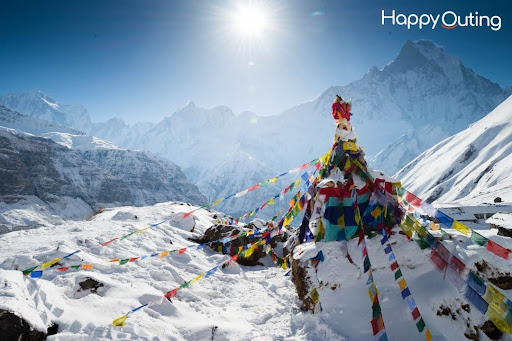The Muktinath is nature-oriented pilgrimage and sanctified; it stands perched on the trans-Himalayan region of Nepal, thus considered very much sacred for Hindu as well as Buddhist followers. It is in the Mustang district at an altitude of about 3,800 meters or 12,467 feet; it is famous for the permanent lamp and 108 water spouts. But can you go to Muktinath during snowfall remains a very common question among travelers.
Yes, if careful and prepared. The snowfall and travel to Muktinath make an exciting experience given the right circumstances, but one must plan properly.
What Happens in Muktinath During Snowfall?
It does snow in Muktinath in the winter months: December, January, and February. Temperatures fall sharply with the mercury sometimes dropping below 10 under zero at night. The whole region dresses in snow sheets, enthralling the observer with the beauty of the place but a risky one, indeed.
Now here comes the problem of slippery paths, roads, and even temple steps. The improper type of dressing in such high-altitude and intense-cold settings surely may lead to grave health issues like altitude sickness or frostbite.
Is the Temple Open for Visits during Snowfall?
Muktinath temple is open throughout the year, including winter. But in times of heavy snowfall, access becomes the primary difficulty. Snow accumulation may block the Jomsom to Muktinath route, particularly at its last section from Kagbeni to Ranipauwa (the closest point to the temple).
During heavy snowfalls, motor road transport by jeep almost stops functioning, while at times flights from Pokhara to Jomsom get canceled because of poor weather conditions. Also, the trails get frozen thus becoming tough for trekking.
Yet the journey can be made and even enjoyed with careful planning, local guides, and necessary gear.
The Pros and Cons of Visiting Muktinath During Snowfall
✅ Advantages
- Fewer Tourists: This is winter, the off-season, so you can be there in peace absorbing the spiritual aura of Muktinath with very few company.
- Scenic Views: Snow-clad peaks and white valleys create a dreamy and serene atmosphere.
- Cheap Accommodation: Hotel and lodge rates in the off-season go down.
❌ Challenges
-
- Unpredictable weather: Snowfall or windstorms may suddenly delay your journey.
- Limited transport: Flights and jeep services might very well be canceled due to snow.
- Physical hazards: Weirdly, it might be cold even up there, and, with slippery trails, can be hazardous without the right gear.
Important Tips for Snowfall Season Travel
During the snowfall season are some essential tips before traveling in order to visit Muktinath:
- Clothing: Carry heavy woolens, thermals, gloves, snow boots, and a windproof jacket.
- Insurance: Choose perhaps a package that may cover flight cancellations due to altitude sickness.
- Keep Hydrated: Even in cold weather, severe dehydration may present difficulties.
- Local Support: Bring along local guides who know winter routes and hazards well.
- Acclimatization: One or two days’ stay in Jomsom or Kagbeni for acclimatization.
Planning a Trip in Snowy Season: The Best Way
If you set your mind to a winter trip, then you must book a Muktinath tour package from Gorakhpur. Usually, these packages take in transportation, meals, accommodation, permits, and local guides, simultaneously making the whole journey easier and safer in hard weather.
The point of origin required for the Muktinath tour package from Gorakhpur is famous among Indian travelers since it is just near the Nepal border. Tour operators offering Muktinath tour packages from Gorakhpur usually provide some flexibility in their routes as well as an emergency backup plan, which is quite useful during winter.
Similarly, any well-assembled Package of Nepal including Kathmandu, Pokhara, and Muktinath is wise to consider. It gives travelers a chance to enjoy other beautiful parts of Nepal should the Muktinath route get temporarily obstructed by weather.
Alternative Routes to Muktinath
During snowfall, flexibility is critical. Here are a few travel options:
- By Flight: From Pokhara to Jomsom by flight, then a Jeep or pony rides to Muktinath (best option, but depending on weather).
- By Road: Gorakhpur-Sunauli-Pokhara-Beni-Jomsom-Muktinath. It is long enough to be taxing when snowing; however, if roads are open, it might be done.
- Helicopter Charter: Those with bigger purses can charter helicopters from Pokhara to Muktinath, often working in light snowfall.
Who Should Avoid Traveling in Snowfall?
Traveling should be avoided by people having some respiratory issues or some heart condition and any senior citizen who is not used to cold temperatures in Muktinath during heavy snowfall. Further, very young children in the family might find it too risky and uncomfortable.
Final Words
Traveling to Muktinath in snowfall is possible but it involves faith and beauty and therefore courage and caution. The snow-covered trails in silence, the temple enduring through ice and winds, and offering prayers physically on the very spot in difficult conditions together form a very moving experience.
If you set your mind to going through it, plan well, pack well, and keep safety as your foremost concern. Whether you intend to take Package of Nepal or Muktinath tour package from Gorakhpur, make sure that your package is arranged by persons experienced in winter travels through the Himalayas.
In the end, snowfall might indeed limit the journey, but here is where it adds to the charm of Muktinath.

